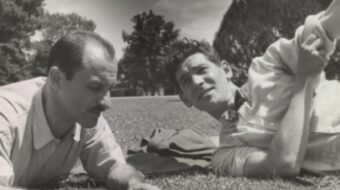
Editor’s Note: News just broke of Sinéad O’Connor’s death at the age of 56. People’s World is sharing this review of a recent documentary O’Connor’s life with our readers.
When it comes to popular culture, perhaps the most notorious incident Sinéad O’Connor is known for is tearing up a picture of Pope John Paul II on live national television during a musical performance. Yet, in taking a deeper look at her early days, her rise to stardom, and her turbulent journey in the public eye, you realize her influence and artistry goes far beyond that moment.
O’Connor is a woman that dared to define herself in a system that often aims to take away a woman’s autonomy. She dared to grapple with uncomfortable societal truths, make mistakes, and simply be human. The new documentary Nothing Compares invites the audience to take a closer look at O’Connor’s life through the lens of the times she lived in and the movements that defined her. The film boldly puts heartbreak, triumph, and politics on full display in a way that is unflinching and eerily relevant today.
Directed by Kathryn Ferguson (Taking the Waters, Space to Be), Nothing Compares follows Sinéad OʼConnorʼs rise to worldwide fame while examining how she used her voice at the height of her stardom to bring attention to social issues worldwide. The film digs deeper into how O’Connor’s desire to be a protest singer and an artist—rather than an apolitical pop star—led to her exile from the musical mainstream.
Focusing mainly on the years 1987 to 1993, the archive-led documentary features a number of music videos, concert performances, and previously unseen footage from this period. O’Connor herself is involved in the film; she gives a new interview that reflects on events in her own words from a present-day perspective. The film intertwines O’Connor’s story with broader themes of Irish history, politics, and global activism in a captivating way.
Perhaps one of the most powerful aspects of the documentary is that it makes the intentional choice to have O’Connor’s story viewed within the framework of the larger struggles happening during her early career. This is important because far too often when it comes to films about famous influential figures—particularly in the creative arts—the approach is a very insular one. Artists are presented as existing in some sort of vacuum where they came to their works solely on the basis of their inner world.
Nothing Compares pushes against that narrative by making it clear O’Connor was very much affected by society, along with her lived experiences, and that greatly influenced how she moved as a singer. Due to this impactful choice by director Ferguson, we are allowed an even better understanding of O’Connor’s important part in living history.
There’s a real focus on the artist’s home country of Ireland. The singer explains how the Catholic Church had such a strong hold over her upbringing, her family, and the place she was born. With this exploration of the history of Ireland and the church’s influence, viewers get a peak at the political struggles in the country as a whole.
There’s a layered history of oppression and rebellion—the internal and external struggles of Ireland. It’s an interesting juxtaposition in seeing O’Connor’s own journey somewhat mimic that rollercoaster of history. The most prominent issue in relation to the singer deals with the controversies surrounding the Catholic Church. This is important because it helps viewers get an even deeper understanding of what fueled O’Connor’s now iconic Saturday Night Live (SNL) performance in 1992.
To be clear, the film isn’t necessarily an outright condemnation of religion. Rather, it looks at the detrimental influence of those that ran the church and that institution’s intertwining with sexism and patriarchy. For example, we are introduced to the topic of the Magdalene Laundries in Ireland, also known as Magdalene asylums. They were institutions often run by Roman Catholic orders and were places so-called “fallen women” were sent to and subjected to slave labor and harsh treatment.
These asylums were in use from the 18th to the late 20th century. An estimated 30,000 women were confined in them, and it wasn’t until 2013 that Ireland made a formal apology for this history. We’re shown in the film that O’Connor has a direct connection to the asylums.
This also helps understand the power of narrative, and how the mainstream media’s use of it painted a picture of O’Connor that aimed to make a mockery of her activism, rather than understanding the nuance of it. Then again, as we are shown in Nothing Compares, the singer has always been pushing against the boxes the mainstream media has aimed to place her in.
It’s interesting to watch how the singer’s unique style and probing lyrics endeared her to the mainstream initially, but when that same authenticity began to shed light on inconvenient truths, O’Connor was quickly painted as public enemy number one. It’s as though a woman is only allowed to be “edgy” in so much as it can be commodified, but not when that edginess is used to dismantle the oppressive status quo.
Does this mean O’Connor was ahead of her time? One could argue she was right on time in using her music to talk about racism, abuse, sexism, and related issues. Those allowed to control the story, however, were determined not to let her message gain the credibility it deserved.
An example of this is the notorious SNL performance that earned her vilification. There was the idea that she engaged in blasphemy for ripping up a picture of Pope John Paul II, but impulse behind the incident was vindicated years later when it was revealed he had been involved in covering up years of sexual abuse within the Catholic Church.
I would argue that the only real shortcoming of the doc is that we don’t get an in-depth look at the years after 1993. They are summarized briefly, but not much detail is given. We are allowed to see how the movements O’Connor spoke up for (such as abortion rights in Ireland) came to fruition. Yet, we aren’t really given a closer look into the fact that, despite the backlash, she continued to record a number of albums and go on tour. We’re told as much, but it would have been nice to see it more as well.
This film dares the world to go back and analyze the persecution O’Connor received and ask why. It also challenges the idea of protest music and its exclusion from the mainstream. O’Connor belongs to a long history of those who used the majority of their music to question systemic oppression. This includes the likes of Pete Seeger, Woody Guthrie, Rage Against the Machine, and others. She dared to be a woman in this arena and, although there were triumphs, she suffered trauma and ridicule.
It’s a powerful film for a powerful figure. Hopefully it pushes viewers to revisit her albums, or perhaps listen to her songs for the first time. Women are still battling for autonomy under a patriarchal profit-driven system. Highlighting complex icons like O’Connor is a necessity in understanding the battles fought, won, and still being waged today.
Nothing Compares will be available to stream for SHOWTIME subscribers Friday, Sept. 30, 2022, ahead of its on-air premiere Sunday, October 2 at 10 p.m. ET/PT. The documentary will be released theatrically in the U.K. and Ireland on Friday, Oct. 7.










